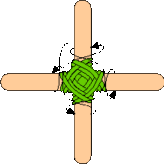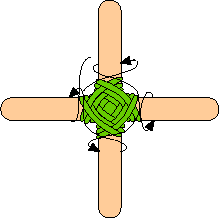Make New Friends

Interestingly, in doing my research I found another verse to this song that I’d never been taught! We always just sang the first verse in our meetings, and even in going away to Girl Scout camp, I never learned another version. I wonder if this is a regional thing? If you know, please share!
Make new friends, but keep the old,
One is silver and the other’s gold.
A circle’s round, it has no end,
That’s how long I want to be your friend.Friendships come and friendships go,
But we’ll be together, this I know.
You’ll need me and I’ll need you,
And together we will make it through.
Buy the Girl Scout Pocket Songbook here for full sheet music.![]()
Basic Wound Care
It is important to be able to identify a wound and care for it. Accidents are common, especially when participating in outdoor activities. While all serious injuries should be checked out by a doctor or other health care professional, leaders and camp counselors should know basic wound care to attend to an injury between the accident site and a trip to a medic. Wounds are subject to infection and bleeding, so attention is required. A wound is defined as a break in the skin or mucous membrane. It is caused by force and usually extends into the underlying tissue. Wounds may be classified into four types:
- Abrasions, made by rubbing or scraping. Floor burns or scuff burns, although called burns, are actually wounds.
- Incised wounds, sharp cuts that tend to bleed freely.
- Lacerated wounds, jagged or irregular wounds, often associated with much tissue damage.
- Puncture wounds. A tack, run through the skin, makes a typical, small puncture wound.
Caring for wounds in which bleeding is not severe is easily done. All adults working with children should know the basic steps.
- Wash your hands thoroughly with clean water and soap.
- Cleanse the injury thoroughly, using plain soap and boiled water cooled to room temperature or clean running tap water and soap.
- Apply the soap and water with a sterile dressing.
- Apply a dry sterile or clean dressing, and bandage it snugly into place.
- See a doctor promptly if evidence of infection appears.
For wounds in which bleeding is server, the objective is to stop the bleeding at once. Always stop the bleeding with pressure directly over the wound with a cloth, if possible. Loss of over a quart of blood may be serious, especially in young children, the aged, and debilitated.
- Direct pressure. Use a clean cloth or a part of the clothing in real emergencies. Apply direct pressure directly over the wound. After the bleeding has been controlled, apply additional layers of cloth to form a sufficient covering, then bandage snugly or firmly.
- Pressure to the supplying vessel. Use the heel of your hand to press the supplying vessel against the underlying bone. Such pressure causes the bleeding to diminish, but doesn’t stop it entirely.
Here are some other tips when dealing with all kinds of wounds:
- If an extremity is involved, elevate it, using pillows or substitutes.
- If there is a delay getting professional medical care, make sure to give the injured person plenty of water if they’re thirsty. You want to make sure they’re properly hydrated. Do not give alcoholic drinks, or give water if there is a penetrating wound of the abdomen or lower chest.
For more, consult the American Red Cross.
Read MoreGod’s Eyes

I wish I knew of a non-religious name for this craft, but this is what they’ve always been referred to as long as I’ve known how to do them. The project originates in Mexico and Bolivia and is known in Spanish as Ojo de Dios, which translates to God’s Eyes. These can be used as decoration anywhere or even ornaments for a Christmas tree during the holidays. The way I’ve written the directions, you’ll have to tie off colors to switch cleanly between them, but in the Quick Shopping links at the bottom I’ve found some multicolor skeins of yarn. These types of yarn vary throughout the skein in different colors, so that might be an interesting way to vary the color but avoid the tie off of the different colors. It’s a handy trick when you don’t have a lot of time to complete the project or when working with younger girls who might not have the patience or dexterity to tie off between colors.
Want to share photos of your troop and finished projects? Contact Us!
![]() Materials Needed:
Materials Needed:
- 2 small, straight sticks about 5″ long OR 2 craft sticks
- Scissors
- Pencil
- 1-3 skeins of yarn in various colors
![]() Directions:
Directions:
- Cross the sticks at the center. Tie them together with the end of a piece of yarn, making an X, but don’t cut the yarn off its skein. Tie the yarn IN BACK of the 2 crossed sticks.
- With the pencil, number the sticks at the ends, in the center. This isn’t necessary, but will make these directions much easier to follow.
- Bring the yarn to the front between sticks 3 and 4. Pull the yarn over stick 3 and the next one too (stick 2), and bring it to the back between sticks 2 and 1. Wrap it behind stick 2 and bring it to the front again between sticks 2 and 3. Pull it over stick 2 and the next one too (stick 1), and wrap it behind stick 1.
- Pull the yarn over stick 1 and the next one too (stick 4) and wrap it behind stick 4. Pull it over stick 4 and the next one too (stick 3) and wrap it behind stick 3. This is one complete round. Always lay the yarn next to, NOT on top of the yarn already in place.
- Keep on wrapping the yarn behind each stick, over that stick and the next, and around behind that one, then over that stick and the next and behind that one. As you continue making the rounds, always be sure that the yarn lies next to, but never on top of the yarn in the previous round. After the first few rounds, you will see the woven pattern of the “eye” beginning to form.
- When you have an “eye” in one color of yarn, you can cut the yarn and tie on another color, and continue weaving. Make sure that the knot that you joined the 2 colors with, stays in the back.
- Keep weaving the “God’s Eye” until you are about ½” from the ends of the sticks. Cut the yarn, leaving approximately a 7-8″ tail. Tie the tail in a knot in back.
This diagram from About.com should help:

![]() Safety Tips!
Safety Tips!
- This is an all-ages project, but adult supervision is required of younger girls when using the scissors.
